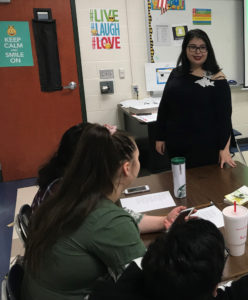• by Alyssa Diaz • IDRA Newsletter • August 2019 •
 During my senior year of high school, I had the rare opportunity to design and teach a lesson to my peers. Although wary about whether or not my classmates would take me or my work seriously, I was eager to fill a gap in the curriculum that stood out to me all year: the lack of multicultural literature, especially Chicano stories and poems.
During my senior year of high school, I had the rare opportunity to design and teach a lesson to my peers. Although wary about whether or not my classmates would take me or my work seriously, I was eager to fill a gap in the curriculum that stood out to me all year: the lack of multicultural literature, especially Chicano stories and poems.
So, together with a friend, I began the hunt for the perfect poem – something easily digestible, yet complex enough to be thoroughly analyzed by a class of AP English IV students. The poem, La Tierra, came to me after digging through an anthology of one of my favorite poets: Abelardo Delgado.
Now armed with my own knowledge of the Chicano culture and what I believed to be the ideal poem, I descended into the classroom trenches to face the terrifying reality of the potential responses of my peers, whose different ethnic backgrounds include Jamaican and Filipino along with African American, Mexican American and Anglo.
With access to a diverse classroom, I was equally intrigued by and scared of how they would react to a poem with a Spanish title that contained a fair amount of code switching throughout. I was afraid because I had chosen a poem that was so representative of my culture – a culture deeply intertwined with my identity, causing any criticism toward the piece to feel like a personal attack.
This is something I imagine every good teacher experiences. Even when the subject is not as intimate as their culture, they still spend hours combing through material until they find something both teachable and, hopefully, enjoyable to their students.
Mexican American Studies – IDRA Services – IDRA provides training that supports educators in offering Mexican American Studies in public schools. Our professional development covers a range of topics for all grades. Topics can include the teaching of content-specific MAS courses and/or tools educators can use to incorporate cultural sustainability into any curriculum. Get details!
In this moment, it became clear to me how the saying, “You can’t please everyone,” manifests itself in the classroom. When deciding what my peers would be turning in to earn their grade, I took everything into consideration: the reality of a senior class in the last six weeks of school, after AP testing and with graduation approaching swiftly. So I had them do something long since forgotten: an illustration.
I put students in groups and had them collectively draw a picture that they believed adequately represented a stanza from the poem. Although drawing does not better a student’s writing, I find that it can be extremely useful to strengthen a student’s ability to analyze and contextualize poetry.
By putting them in groups, I intensified the effects. They had to voice their interpretation in a way that their peers could understand and relate to an image. I simultaneously exposed students to different perspectives and interpretations of the same poem.
When students see their own culture, or simply another underrepresented culture, they are far more likely to be engaged with the lesson. That increases academic quality and inclusivity for all students.
When my lesson was complete, I was surprised to have students stop me to say that it was their favorite poem they read all year, because it was rare to see their own stories taught in the classroom. Others excitedly drew connections between the Mexican American culture and their own. All of this solidified my belief that students are hungry to see different cultures and voices represented in schools.
When students see their own culture, or simply another underrepresented culture, they are far more likely to be engaged with the lesson. That increases academic quality and inclusivity for all students.
![]()
Alyssa Diaz is a recent high school graduate from San Antonio.
[©2019, IDRA. This article originally appeared in the August 2019 IDRA Newsletter by the Intercultural Development Research Association. Permission to reproduce this article is granted provided the article is reprinted in its entirety and proper credit is given to IDRA and the author.]



